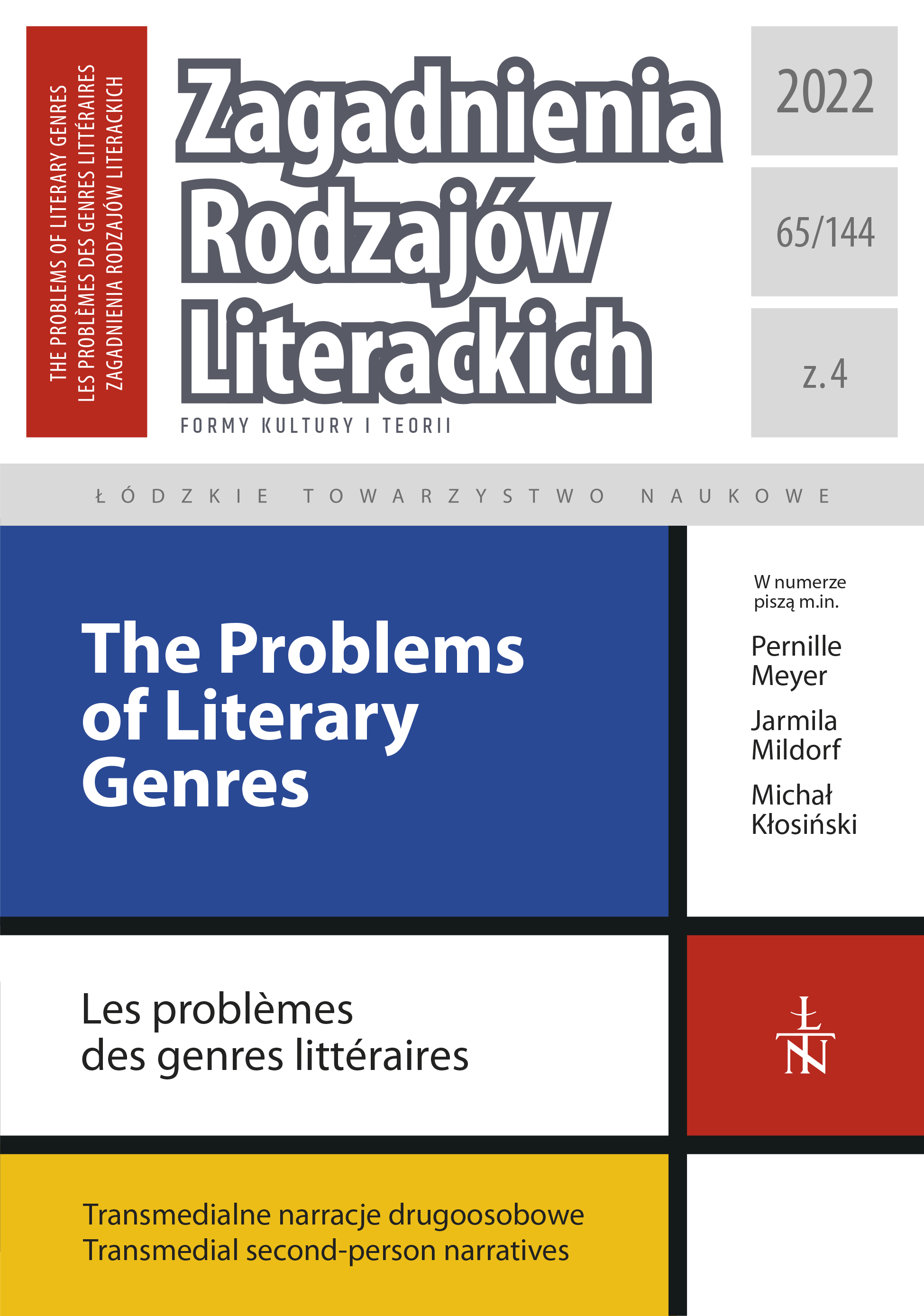„You are that”. The Role of Second-Person Narrative in Pawel Palinski’s Novel Polaroids from Doom
DOI:
https://doi.org/10.26485/ZRL/2022/65.4/8Keywords:
Paweł Paliński, Polaroidy z zagłady (Polaroids from Doom), second-person narrative, polish literatureAbstract
This article is an analysis of Paweł Paliński’s novel Polaroidy z zagłady (Polaroids from Doom) in the context of its use of second-person narrative. Paliński’s work describes a post-apocalyptic world where people have turned into mindless, lethargic creatures. This is the reality in which the sole survivor of the apocalypse and the main heroine of the story, Teresa Szulc, struggles to persevere. The novel approaches the topics of returning to a normal life after a crisis and human solitude in a particularly interesting way. The main lens through which the novel is examined is through Jacques Lacan’s psychoanalytical theory, whose application enables this interpretation of Polaroidy… as a story about the disintegration of the symbolic order. Themes that are crucial to understanding this aspect of the narrative include: the permanent absence of the other person, the lack of an external perspective on oneself, and the nonexistence of potential spectators. Teresa Szulc feels hauntingly lonely, because no one can see her — and those are the circumstances in which she has to ask herself who she actually is. Because of this, the use of the second-person narrative seems especially thought-provoking. The heroine is indeed alone in this world, and yet someone still speaks to her; the article is an attempt to answer not only the question of the speaker’s identity, but — even more importantly — of the role of such literary strategy and the way in which it affects both the main character and the reader.
Downloads
References
Burszta Jędrzej (2017), Radykalne głosy, marginalne spojrzenia. Spory o współczesny kanon fantastyki [w:] Narracje fantastyczne, red. K. Olkusz, K.M. Maj, Ośrodek Badawczy Facta Ficta, Kraków.
Butor Michel (1971), Użycie zaimków osobowych w powieści, „Pamiętnik Literacki” nr 61(3).
Fink Bruce (1997), Kliniczne wprowadzenie do psychoanalizy lacanowskiej, przeł. Ł. Mokrosiński, Wydawnictwo A. Żórawski, Warszawa.
Freud Sigmund (1997), Niesamowite [w:] S. Freud, Dzieła, t. 3: Pisma psychologiczne, przeł. R. Reszke, Wydawnictwo KR, Warszawa.
Kontrapunkty — Wydawnictwo Powergraph (b.r.), www.powergraph.pl/katalog/serie/kontrapunkty [dostęp: 30.07.2022].
Lacan Jacques (2001), The Seminar of Jacques Lacan. Book II. The Ego in Freud’s Theory and in the Technique of Psychoanalysis, red. J.-A. Miller, przeł. S. Tomaselli, Norton, Londyn–Nowy Jork.
Lacan Jacques (2013), Imiona-Ojca, przeł. R. Carrabino i in., Wydawnictwo Naukowe PWN, Warszawa.
Lacan Jacques (2015), Mit indywidualny neurotyka albo Poezja i Prawda w nerwicy, przeł. T. Gajda, J. Kotara, J. Waga, Wydawnictwo Naukowe PWN, Warszawa.
Lauro Sarah Juliet, Embry Karen (2008), A Zombie Manifesto. The Nonhuman Condition in the Era of Advanced Capitalism, „boundary 2” z. 1.
Lem Stanisław (1995), Cyberiada. Bajki robotów, t. 2, Interart, Warszawa.
Paliński Paweł (2014), Polaroidy z zagłady, Powergraph, Warszawa.
Rembowska-Płuciennik Magdalena (2016), Narracyjne podwojenie jaźni [w:] Projekt na daleką metę. Prace ofiarowane R. Nyczowi, red. Z. Łapiński, A. Nasiłowska, Instytut Badań Literackich PAN, Warszawa.
Rembowska-Płuciennik Magdalena (2017), O przechodzeniu na ty… Narracja diadyczna wśród literackich reprezentacji świadomości bohatera [w:] (W) sieci modernizmu. Historia literatury — poetyka — krytyka. Prace ofiarowane Włodzimierzowi Boleckiemu, red. A. Kluba, M. Rembowska-Płuciennik, Instytut Badań Literackich PAN, Warszawa.
Waldenfels Bernhard (2002), Topografia obcego. Studia z fenomenologii obcego, przeł. J. Sidorek, Oficyna Naukowa, Warszawa.
Žižek Slavoj (2001), Wzniosły obiekt ideologii, przeł. J. Bator, P. Dybel, Wydawnictwo Uniwersytetu Wrocławskiego, Wrocław.
Žižek Slavoj (2018), Patrząc z ukosa. Wprowadzenie do Jacques’a Lacana przez kulturę popularną, przeł. J. Margański, Wydawnictwo Aletheia, Warszawa.







